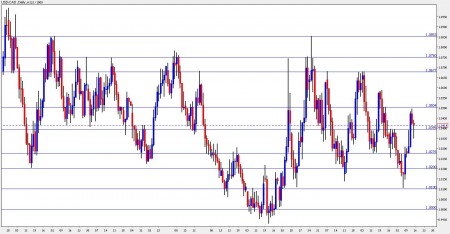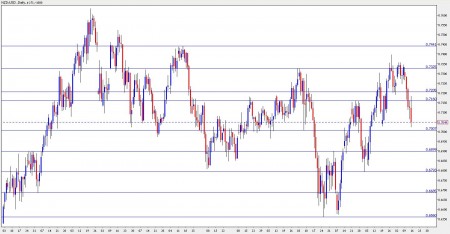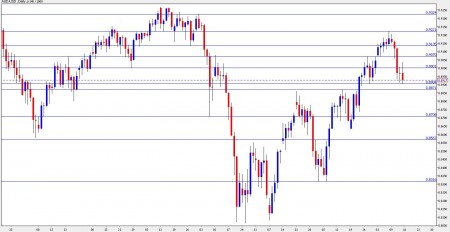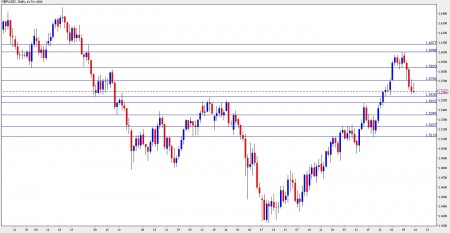Forex Crunch USD/CAD Outlook – August 16-20 |
- USD/CAD Outlook – August 16-20
- NZD/USD Outlook – August 16-20
- AUD/USD Outlook – August 16-20
- GBP/USD Outlook – August 16-20
| USD/CAD Outlook – August 16-20 Posted: 15 Aug 2010 01:52 AM PDT A busy week expects loonie traders, with inflation figures providing a strong finish. Here’s an outlook for the Canadian events and an updated technical analysis for USD/CAD. USD/CAD graph with support and resistance lines on it. Click to enlarge: The Canadian dollar retreated mostly on the FOMC Statement, and not on Canadian issues. This week, USD/CAD will be more dependent on Canadian events. Let’s start:
USD/CAD Technical Analysis The Canadian dollar struggled with the 1.0280 line, and eventually lost it. The rise above 1.04 led to resistance at 1.05 (a line added on last week’s outlook) before closing at 1.0414. USD/CAD now trades between last week’s limit at 1.05 and 1.04, the veteran line that now switches its role once again to a support line. Looking down, 1.0280 remains a minor line of support after working in both directions in recent months. Lower, 1.02, the 2009 low, provides further support. It’s followed by 1.01, which provided support both in May and recently in August. Even lower, the ultimate line of support is the parity line. Looking up, 1.0680 was a stubborn line of resistance in June and in July and will cap a rise by USD/CAD if it breaks above 1.05. Above, 1.0750 was swing top several times in the past year and works as a strong resistance line. Higher, 1.0850 was a swing high in May and also in back in November. I remain bearish on USD/CAD. As the storm from Bernanke’s move calms down, Canadian fundamentals should push the pair lower. Further reading:
Want to see what other traders are doing in real accounts? Check out Currensee. It's free.. |
| NZD/USD Outlook – August 16-20 Posted: 14 Aug 2010 11:39 PM PDT Producer prices are the highlight of this week’s kiwi trading. Here’s an outlook for the events in New Zealand, and an updated technical analysis for NZD/USD. NZD/USD graph with support and resistance lines on it. Click to enlarge: NZD/USD suffered from Bernanke’s move and hardly managed to remain above 0.70. Will it stabilize this week?
NZD/USD Technical Analysis The kiwi failed to settle above 0.7325 at the beginning of the week, and started deteriorating quickly. After losing 0.72 and 0.7160 mentioned in last week’s outlook, NZD/USD closed at 0.7049, a weekly loss of about 250 pips. The kiwi is now supported by the round important number of 0.70, which often supports the pair. Below, 0.69 is the next line of support. It worked as a line of resistance in May, after the pair collapsed. Lower, 0.6790 that was a swing low in July and also supported the pair in February is the next support line. Below, 0.6685 provided support back in September and was a pivotal line in July. The final line is the year-to-date low of 0.6560. Looking up, 0.7160 provides minor resistance, and its followed by 0.72 that worked as support quite recently. Higher, 0.7325 that was an area of struggle and also a peak in May is the next line of resistance, followed by the 0.7440 region. I turn bearish on NZD/USD. After the disappointing quarterly employment data, the kiwi is more vulnerable than others to the gloomy market mood. Further reading:
Want to see what other traders are doing in real accounts? Check out Currensee. It's free.. |
| AUD/USD Outlook – August 16-20 Posted: 14 Aug 2010 06:00 PM PDT Aussie traders expect 6 market moving events in the week after Bernanke’s blow. Here’s an outlook for the Australian events, and an updated technical analysis for AUD/USD. AUD/USD graph with support and resistance lines on it. Click to enlarge: Australia’s job data didn’t exceed expectations as it did in previous month, yet it was still good and helped in stabilizing the Aussie. We have another job-related figure this week. Let’s start:
AUD/USD Technical Analysis After holding above 0.9135 at the beginning of the week, AUD/USD gradually dropped, temporarily fighting on the 0.9135, 0.9070 and 0.90 lines mentioned in last week’s outlook. The Aussie currently ranges between the round psychological 0.90 level, and 0.89 – the bottom line it reached in the past week, which is now a minor line of support. Below, 0.8870 is already a strong support line, being a double top in June and July. Lower, 0.8710 was a swing low in May and later played a role as a pivotal point. It’s followed by the veteran line of 0.8567 which was a double bottom in October and in February and later also worked as a resistance line. Lower, 0.8316 was the bottom line in July and serves as another support line. Looking up, the support levels are now resistance – 0.9070 capped the pair a few weeks ago. 0.9135 worked as support last week and also in April. Higher, 0.9220 was the peak it repeatedly failed to break in the previous week and now serves as strong resistance. Even higher, the long lasting 0.9327 is still waiting. I am neutral on the Aussie. The Australian economy is still doing well and after Bernanke’s initial blow, I expect it to stabilize. This week’s key is the important data about future policy regarding Australia’s high interest rate. Further reading:
Want to see what other traders are doing in real accounts? Check out Currensee. It's free.. |
| GBP/USD Outlook – August 16-20 Posted: 14 Aug 2010 01:45 PM PDT After the Pound got bad news in the past week and fell, another busy week expects cable traders. Inflation data and retail sales being the highlights. Here’s an outlook for the British events and an updated technical analysis for GBP/USD. GBP/USD graph with support and resistance lines on it. Click to enlarge: Apart from the disappointing employment figures, the Pound was also severely hit by the groundbreaking statement from the Federal Reserve, that sent “risky” currencies way down. The focus returns to British figures now. Let’s start:
GBP/USD Technical Analysis After another failed attempt to break above 1.60, GBP/USD began falling. After trading between the 1.57 and 1.5833 lines, it found support only above 1.5530, closing at 1.5586, losing nearly 400 pips. The Pound now trades between 1.5530, which served as tough resistance in April and as support in February, to 1.5720, which held the pair back in 2009, and also temporarily in the past week. Note that most lines haven’t changed since last week’s outlook. Above, 1.5833, which provided support at the beginning of the year and later worked as resistance, is the next line. Higher, the round psychological number of 1.60 proved to be a tough barrier recently and is a very strong resistance line. Higher, 1.6080 is the next minor line of resistance, after serving as support in January. It’s followed by 1.6270, but that’s quite far at the moment. Looking down below 1.5530, the next line of support is quite close – 1.5470 – it capped the pair in its recent ascent. 1.5350 served as pivotal line in March and April and now provides minor support. Lower, 1.5230 was a stubborn resistance line in July and is now a major support line. Even lower, 1.5120 will provide further support. I am neutral on GBP/USD. Despite the pause in employment and King’s dovish statements, Britain is in a much better state than the Euro-zone, and should be able to stabilize in the week after Bernanke’s earthquake. Further reading:
Want to see what other traders are doing in real accounts? Check out Currensee. It's free.. |
| You are subscribed to email updates from Forex Crunch To stop receiving these emails, you may unsubscribe now. | Email delivery powered by Google |
| Google Inc., 20 West Kinzie, Chicago IL USA 60610 | |





No comments:
Post a Comment